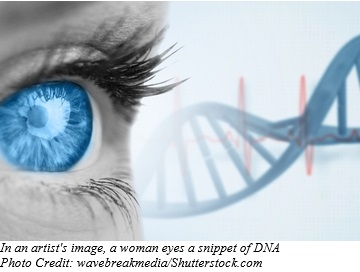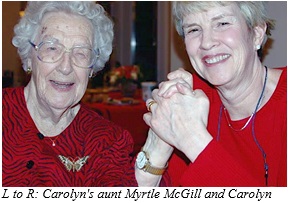By Maychai Brown

This is the story about the gene PALB2, part of the DNA molecule found on chromosome 16. It is also the story of a woman whose DNA contains a faulty copy of that gene. It’s a story composed of two narratives: one about a scientific pursuit and one about a personal journey.
In 1984, at age 39, Carolyn Badger’s life contained more than the usual responsibilities for a woman her age. Besides raising three children—ages 8, 10 and 12—and teaching in the Department of Education at Concordia University, she was caring for her mother who had breast cancer. After a routine mammogram, Carolyn discovered she had a tumour in one of her breasts. The next year and a half was very difficult; surgery, chemotherapy, and radiation treatments were piled onto her other responsibilities.
Four years later, Carolyn discovered she had cancer in her other breast. With three women in her family—her mother, her mother’s sister, and herself—affected by breast cancer, Carolyn remembers thinking, “Something is going on beyond the normal.”
In the same year as Carolyn’s second diagnosis, journalist Sharon Batt, editor of the Quebec Consumer Office’s magazine, Protect Yourself, was diagnosed with breast cancer. Batt started to question some of the societal assumptions about the disease in a series of articles and radio documentaries that caught Carolyn’s attention. Carolyn wrote to Sharon and soon joined a group of women who met in Batt’s apartment to discuss changes the medical community needed to make in their response to the disease.
From these meetings emerged Breast Cancer Action Montreal/Sensibilisation au cancer du sein Montréal (BCAM). Carolyn’s name appears on the original Letters Patent of the organization. Her face, along with those of eight other women, is depicted in Deena Dlusy Apel’s iconic painting One in Nine, which captures both the spirit of the original group of women who met in Sharon Batt’s apartment and their determination to bring attention to the shocking statistic that one in nine women would develop breast cancer. Carolyn would later learn why her odds were far higher.

This was not the end of Carolyn’s breast cancer story. Over the next 18 years years she would experience her third primary (non-metastatic) breast cancer, her mother would die of the disease, and her aunt would battle two more occurrences. She was convinced that the number of breast cancers in her immediate family were not a coincidence. She started to wonder whether this could be an inherited disease.
Meanwhile, researchers around the world were investigating the genetic basis of familial breast cancer. With the development of genetic mapping and other techniques in the last decade of the 20th Century, two major genes were identified: BRCA1 on chromosome 17 and BRCA2 on chromosome 13. These two genes encode the proteins that repair DNA damage that frequently happens when cells divide. If the damage is not repaired, cell division no longer proceeds in an orderly fashion. The result is often a malignant tumour. Mutations to either the BRCA2 gene or the BRCA1 gene are inherited. An abnormal BRCA1 gene confers a 50-70% risk of developing breast cancer by age 70; the risk is slightly lower with an abnormal BRCA2 gene: 40-60% by age 70.
This discovery could explain the breast cancers in Carolyn’s family. To find out whether she had inherited one of the mutated BRCA genes, Carolyn underwent genetic testing. However, the tests indicated both genes were normal.
Meanwhile researchers continued to probe exactly how a healthy BRCA2 gene repairs damaged DNA. In 2006, molecular biologists reported the discovery of a piece of the puzzle: a protein that works in partnership with BRCA2. They named the protein and its gene “PALB2,” which stands for “partner and localizer of BRCA2.”1 Researchers hypothesized that people who inherited a mutated PALB2 gene might be susceptible to breast cancers and other tumours.
Two Montreal onco-geneticists, Drs. Marc Tischkowitz and William Foulkes, were interested in testing that hypothesis. They planned to test for PALB2 mutations in families with multiple breast cancers but no evidence of BRCA1/BRCA2 gene mutations. Carolyn’s surgeon referred her to Dr. Foulkes, who became interested in her family history and asked if she and her elderly aunt, then in her late nineties, would donate blood samples for DNA analysis.
Both Carolyn and her aunt were eager to participate in the research but the logistics proved challenging. The blood was drawn at a location convenient for her aunt. When a courier failed to show up to transfer the blood samples to Dr. Foulkes’ lab, frantic phone calls ensued and Carolyn and her aunt ended up driving the newly drawn samples to the entrance of the Montreal General Hospital, where Dr. Foulkes’ assistant rushed down to retrieve them.
These samples provided valuable information to Foulkes and Tischkowitz. From the analysis of DNA collected from 68 families, they found only two PALB2 mutations and one of these was from Carolyn’s family. In fact, it was a particular mutation that had never been seen before. In 2007, Tischkowitz et al. published the results of their research including a diagram showing 28 members from four generations of Carolyn’s family.2
The data confirmed that inherited mutations in PALB2 are implicated in familial breast cancer predisposition. Although Carolyn’s aunt died before the data was published, she lived long enough to learn that her DNA contained a mutated PALB2 gene. She and Carolyn finally knew why so many breast cancers had emerged in their family. Carolyn recalls that her aunt was proud to have contributed to knowledge that would help others with a family history of breast cancer.
 Although the authors concluded that many more families would have to be studied to arrive at estimates of the risk of developing breast cancer in PALB2 mutation carriers, it was clear from Carolyn’s family history that the previous estimate of a 2.3-fold increased risk was too low.
Although the authors concluded that many more families would have to be studied to arrive at estimates of the risk of developing breast cancer in PALB2 mutation carriers, it was clear from Carolyn’s family history that the previous estimate of a 2.3-fold increased risk was too low.
The next research task was to establish accurate risk estimates for PALB2 carriers in order to develop effective medical interventions for healthy men and women who carry the gene as well as for those who have developed the disease.
Seven years later, in August 2014, Tischkowitz, who was then working at Cambridge University, and Foulkes joined 46 other authors from the U.K., Finland, Greece, Australia, Italy, the United States, and Canada in publishing “Breast Cancer Risk in Families with Mutations in PALB2” in the New England Journal of Medicine. Using information from 364 members of 154 families that carried 48 different mutations of the PALB2 gene, the researchers concluded that the estimated cumulative risk of a PALB mutation carrier developing breast cancer was 35% by age 70. While not as high as it is for carriers of the BRCA1 and BRCA2 mutations, the risk is significant. Dr. Tischkowitz said, “Since the BRCA1 and BRCA2 mutations were discovered in the mid-90s, no other genes of similar importance have been found and the consensus in the scientific community is that if more existed we would have found them by now. PALB2 is a potential candidate to be ‘BRCA3.’”3
Despite determining more reliable estimates of risk, the authors cautioned that “No single set of penetrance estimates applies to all PALB2 mutation carriers.”4 For instance, women who were the only identified mutation carriers within their families had a lower risk of developing breast cancer than women who had two first-degree relatives with early-onset breast cancers. Another variation was that risk increased significantly in mutation carriers born after 1960.
To understand these variations, researchers stress the need for larger cohorts and the need for further research into lifestyle, hormone use, environment, and additional genetic mutations that might increase or decrease risk. In a recent interview, Dr. Foulkes mentioned other established breast cancer risk factors that might also increase the risk for PALB2 mutation carriers: earlier than average age of menarche, later age at first full-term pregnancy, above average age of menopause, and never breastfeeding. Reflecting upon reasons why some PALB2 carriers develop breast cancer while others do not, Carolyn thinks that stress, toxins, and endocrine disruptors in the environment are factors.
Although Carolyn’s mother and aunt had died by the time of publication of the 2014 article, their histories along with many others helped researchers develop more accurate estimates of the probability of developing the disease when one has inherited a PALB2 mutation.
Carolyn now says if she had known that she carried a PALB2 mutation and the degree of risk it meant, she would have opted for prophylactic bi-lateral mastectomy instead of waiting for 22 years, and two additional breast cancers, before choosing to have the surgery.
Considering how these scientific discoveries—genetic testing and estimates of risk—have affected Carolyn’s understanding of her situation, one would hope that other women and men from families with a high incidence of breast cancer would have access to genetic testing for PALB2 mutations. Unfortunately, Quebec’s Institut national d’excellence en santé et en services sociaux (INESSS) does not yet include genetic testing for PALB2 mutations in its list of procedures covered by the Régie de l’assurance maladie du Québec (RAMQ), but the test is available from the private sector.
- Xia, B. et al. Control of BRCA2 cellular and clinical functions by a nuclear partner, PALB2. Mol Cell. 22(6):719–729. 2006.05.22.
- Tischkowitz et al. Analysis of PALB2/FANCN-associated breast cancer families. PNAS. 104(16):6788-6793. 2007.04.11.
- Quoted online in BioNews. Bryon-Dodd, K. Cancer risk genes: could PALB2 be BRCA3? 2014.08.11
- Antoniou, A. C. et al. Breast-cancer risk in families with mutations in PALB2. NEJM. 371(6):497-500. 2014.08.07.
